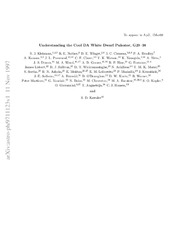Solheim, Jan Erik; Kleinman, S. J.; Bruvold, A.; Nather, R. E.; Winget, D. E.; Clemens, J. C.; Bradley, A.; Kanaan, A.; Claver, C. F.; Watson, T. K.; Yanagida, K.; Nitta, A.; Dixson, J. S.; Grauer, A. D.; Hine, B. P.; Fontaine, G.; Liebert, James; Sullivan, D. J.; Wickramasinghe, D. T.; Achilleos, N.; Mara, T. M. K.; Seetha, S.; Ashoka, B. N.; Leibowitz, E. M.; Moskalik, P.; Krzesi´nski, J.; O’Donoghue, D.; Kurtz, D. W.; Warner, B.; Martinez, Peter; Dolez, N.; Chevreton, M.; Barstow, M. A.; Kepler, S. O.; Giovannini, O.; Hansen, C. J.; Augusteijn, T. (Journal article; Tidsskriftartikkel; Peer reviewed, 1997-10-10)
The white dwarfs are promising laboratories for the study of cosmochronology
and stellar evolution. Through observations of the pulsating white dwarfs, we can
measure their internal structures and compositions, critical to understanding post main
sequence evolution, along with their cooling rates, allowing us to calibrate their ages
directly. The most important set of white dwarf variables to ...


 English
English norsk
norsk